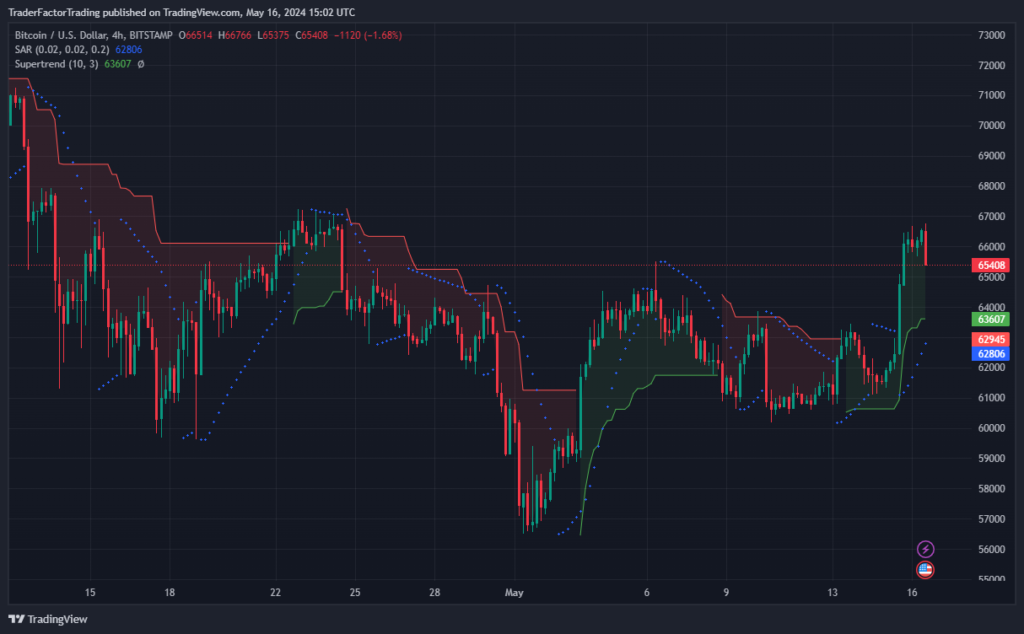Bitcoin (BTC) surged past $66,000 for the first time since April 24, driven by softer-than-expected U.S. inflation data and sluggish retail sales. The rally was a welcome boost for cryptocurrency investors, economic analysts, and financial traders who had been watching the market closely.
Table of Contents
ToggleBitcoin Hits $66K as Soft Inflation Data Sparks Crypto Rally
Crypto markets rallied on Wednesday as softer-than-expected U.S. inflation data jolted digital assets from their recent stagnation. Bitcoin climbed to its highest price since April 24, rising more than 7.5% in a single day. This surge was driven primarily by the latest U.S. Consumer Price Index (CPI) figures, which edged lower from March, along with a slightly sluggish retail sales report.
BTCUSD 4-hour Chart

U.S. Inflation Data Provides Relief
The April CPI report showed a 0.3% increase in consumer prices, with a year-on-year rise of 3.4%. Core CPI, which excludes volatile food and energy prices, also gained 0.3%, up 3.6% year-on-year. This data came as a relief to investors who had been fearing that reaccelerating inflation and a red-hot economy might force the Federal Reserve to reconsider its dovish stance and even contemplate interest rate hikes.
Market Implications and Interest Rate Expectations
The softer inflation data raised the probability of an interest-rate cut by the Federal Reserve in the coming months. Like other risk assets, Bitcoin is sensitive to expected changes in the monetary policy of major central banks and rallies when the cost of borrowing is forecast to decline. Markets also expect the Bank of England and European Central Bank to cut rates in June.
Retail Sales and Economic Cooling
Hopes of the Federal Reserve starting its easing cycle this year were further bolstered by other data on Wednesday showing retail sales were unexpectedly flat last month. Core sales, which exclude automobiles, gasoline, building materials, and food services, dropped 0.3%. These reports suggested that domestic demand was cooling, which will be welcomed by officials at the U.S. central bank as they try to engineer a “soft landing” for the economy.
Mortgage Rates and Future Projections
Mortgage rates are poised to fall based on the latest inflation report, with early surveys indicating that the 30-year mortgage rate has already dipped below 7%. The April CPI report coming in softer than expected points to a potential moderation in mortgage rates later this year.
Understanding the Consumer Price Index (CPI)
The Consumer Price Index (CPI) measures the monthly change in prices paid by U.S. consumers. The Bureau of Labor Statistics (BLS) calculates the CPI as a weighted average of prices for a basket of goods and services representative of aggregate U.S. consumer spending. The CPI is one of the most popular measures of inflation and deflation, differing in survey methodology, price samples, and index weights from the producer price index (PPI), which measures changes in the prices received by U.S. producers of goods and services.
Conclusion
The recent surge in Bitcoin’s price to $66,000, driven by softer U.S. inflation data and sluggish retail sales, has provided a much-needed boost to the cryptocurrency market. As investors and traders digest this information, the focus will remain on the Federal Reserve’s upcoming policy decisions and their potential impact on the wider financial market.
For cryptocurrency investors, economic analysts, and financial traders, staying updated with these developments is crucial. The evolving landscape of economic indicators and their implications on digital assets continues to offer both opportunities and challenges.
Disclaimer:
All information has been prepared by TraderFactor or partners. The information does not contain a record of TraderFactor or partner’s prices or an offer of or solicitation for a transaction in any financial instrument. No representation or warranty is given as to the accuracy or completeness of this information. Any material provided does not have regard to the specific investment objective and financial situation of any person who may read it. Past performance is not a reliable indicator of future performance.

















